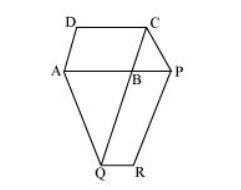Question.
The side AB of a parallelogram ABCD is produced to any point P. A line through A and parallel to CP meets CB produced at Q and then parallelogram PBQR is completed (see the following figure). Show that ar (ABCD) = ar (PBQR).


Solution:

Let us join AC and PQ.
$\triangle A C Q$ and $\triangle A Q P$ are on the same base $A Q$ and between the same parallels $A Q$ and $C P$.
$\therefore$ Area $(\triangle A C Q)=$ Area $(\triangle A P Q)$
$\Rightarrow$ Area $(\triangle A C Q)-$ Area $(\triangle A B Q)=$ Area $(\triangle A P Q)-$ Area $(\triangle A B Q)$
$\Rightarrow$ Area $(\triangle A B C)=$ Area $(\triangle Q B P) \ldots(1)$
Since $A C$ and $P Q$ are diagonals of parallelograms $A B C D$ and $P B Q R$ respectively,
$\therefore$ Area $(\triangle A B C)=\frac{1}{2}$ Area $(A B C D) \ldots$(2)
Area $(\triangle \mathrm{QBP})=\frac{1}{2}$ Area $(\mathrm{PBQR})$...(3)
From equations $(1),(2)$, and $(3)$, we obtain
$\frac{1}{2}$ Area $(A B C D)=\frac{1}{2}$ Area $(P B Q R)$
Area $(A B C D)=$ Area $(P B Q R)$

Let us join AC and PQ.
$\triangle A C Q$ and $\triangle A Q P$ are on the same base $A Q$ and between the same parallels $A Q$ and $C P$.
$\therefore$ Area $(\triangle A C Q)=$ Area $(\triangle A P Q)$
$\Rightarrow$ Area $(\triangle A C Q)-$ Area $(\triangle A B Q)=$ Area $(\triangle A P Q)-$ Area $(\triangle A B Q)$
$\Rightarrow$ Area $(\triangle A B C)=$ Area $(\triangle Q B P) \ldots(1)$
Since $A C$ and $P Q$ are diagonals of parallelograms $A B C D$ and $P B Q R$ respectively,
$\therefore$ Area $(\triangle A B C)=\frac{1}{2}$ Area $(A B C D) \ldots$(2)
Area $(\triangle \mathrm{QBP})=\frac{1}{2}$ Area $(\mathrm{PBQR})$...(3)
From equations $(1),(2)$, and $(3)$, we obtain
$\frac{1}{2}$ Area $(A B C D)=\frac{1}{2}$ Area $(P B Q R)$
Area $(A B C D)=$ Area $(P B Q R)$
